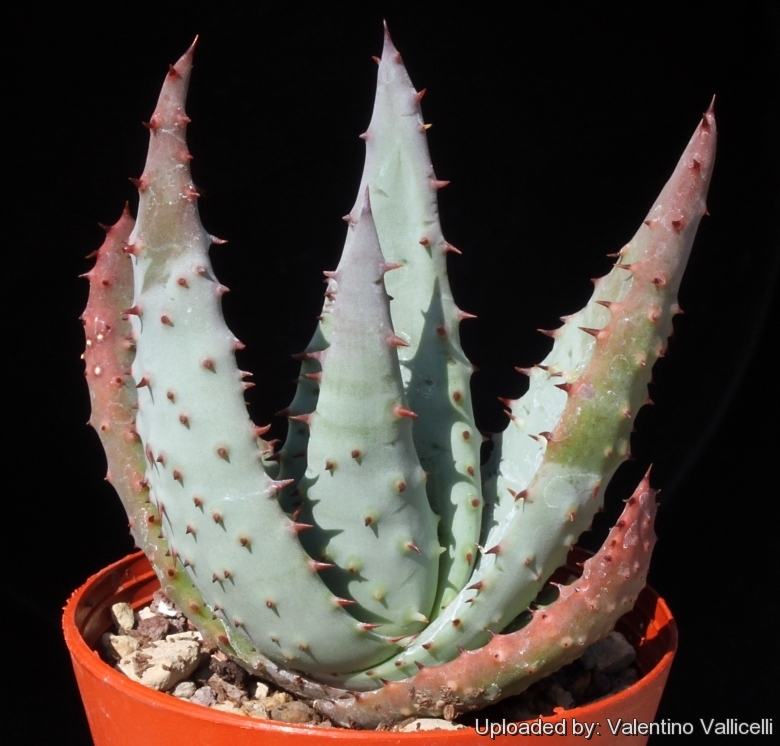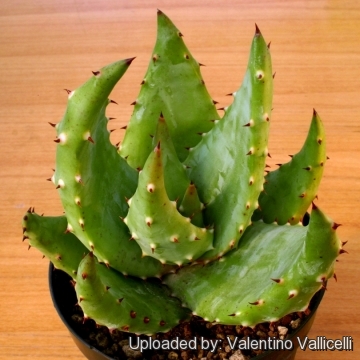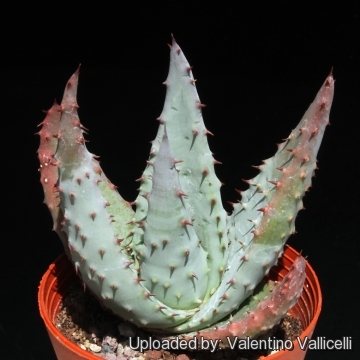




Your support is critical to our success.

It is easily identified from other similiar species with conspicuous sharp spines on the leaves in that it is the only known aloe whose spines spring from tuberculate white base bumps. It is perhaps one of the most well known Aloes to South Africans as it was depicted on the old nickle 10 cent piece.
Origin and Habitat: Aloe aculeataSN|594]]SN|594]] can be found in several areas in south Africa (Northern Province, Mpumalanga) and it extends into Zimbabwe.
Habitat: It is found in rocky areas in grassland and open bushveld.
Synonyms:
- Aloe aculeata Pole-Evans
ENGLISH: Red Hot Poker Aloe
Description: Aloe aculeataSN|722]]SN|594]] is a (usually) solitary stemless rosette which grows up to approximately 60(-100) cm high, 30(-100) in diameter if not contained by pot. The name 'aculeata' means prickly and refers to the presence of the many tuberculate spines on the leaf surfaces.
Rosette: Each rosette is composed by flattish fat leaves that arch upward like a bowl, though as plants age, plants tend to fall over a bit and lose this semicircular sillohuette.
Leaves: Long and quite broad at the base , 120mm wide, from dull green to turquoise with reddish-brown triangular teeth (or thorns) on the margins and undersides. These warty spines have a different white base colour which give the plant a mottled appearance. The spines is variable, and many older plant populations have no more spines.
Flowers: Some specimens are uniform in colour while others bicoloured, Colors are variable from red to orange to red and yellow, all the way to greenish yellow. Flowers are tubular in shape, 40mm in length, and flattened downward helping distinguish this aloes from most other non-suckering, stemless South African Aloes.
In young plants the infloresence is single up 1 m tall, as the plant matures the inflorescence may split into three or four branches. Each raceme is long and narrow and gradually tapers to the tip.
Blooming season: Mid winter (in northern hemisphere) .
Remarks: Aloe pegleraeSN|594]]SN|722]] can be mistaken for Aloe aculeataSN|722]]SN|594]] when not in flower, but the presence of thorns on both leaf surface is a characteristic unique to Aloe pegleraeSN|594]]SN|722]].
Bibliography: Major references and further lectures
1) Urs Eggli “Illustrated Handbook of Suculent Plants: Monocotyledons” Springer, 2001. Pages 114-115
2) Susan Carter, John J. Lavranos, Leonard E. Newton, Colin C. Walker “Aloes. The definitive guide.” Kew Publishing, Royal Botanic Gardens, Kew 2011, ISBN 978-1-84246-439-7, S. 251.
3) Gordon D. Rowley “The illustrated encyclopedia of succulents” Crown Publishers, 01/Aug/1978

Aloe aculeata Photo by: Valentino Vallicelli

Aloe aculeata Photo by: Valentino Vallicelli
Cultivation and Propagation: Aloe aculeataSN|594]]SN|594]] is relatively easy to cultivate under a wide variety of climatic conditions provided it is planted in a well-drained situation given adequate water but not over-watered.
Soil: Grow it in an open sandy-gritty cactus compost. Needs good drainage.
Pots: It needs a relatively shallow pot to accommodate its fibrous roots and provide a very good drainage. It may stay in the same pot for many years.
Watering: This species requires regular water in summer, but is dormant and needs very little water in winter. Keep dry in winter or when night temperatures remain below 10° C. Water it less than average if in bigger pots.
Special need: Provide very good ventilation. Nearly all problems occur as a result of overwatering and poor ventilation, especially when weather conditions are dull and cool or very humid.
Fertilization: Light fertilizer seems to boost its growth whenever additional water is given.
Feed them during the growing season with a fertilizer specifically formulated for cactus and succulents (high potash fertilizer with a dilute low nitrogen), including all micro nutrients and trace elements diluted to ½ the strength recommended on the label. They thrive in poor soils and need a limited supplies of fertilizer to avoid the plants developing excess vegetation, which is easily attacked by fungal diseases.
Exposure: It enjoys light-shade. It may be grown in full sun too but protect in summer from afternoon sun, and avoid reflected heat. It will do its best with some sun and become stressed with inadequate light which could result in poor growth and unnatural shape. Leaves given ideal light conditions (direct sunlight) turn a lovely red and orange, they tend also to turn red with low water and cold situations, a sign generally associated with stress.
Hardiness: It likes warmth (recommended minimum winter temperature 5° C) however plants kept perfectly dry can can survive low temperatures, approx. -2° for short periods, but for safe cultivation it is best to avoid freezing temperatures.
Use: It can be cultivated outdoors in raised beds, terraces if sheltered from winter rain. It grows much better outdoors in spring and summer, it is also adapt for the bright windowsill.
Maintenance: Removal of old flower stalks.
Pest and diseases: Occasionally these plants are infested by scale and aphids, but all known garden pests can be kept to a minimum by simply ensuring optimal growing conditions and healthy plants.
Propagation: Propagation is by seed, as it seldom offsets. Seeds must be sown as fresh as possible. The best time for sowing would be in the spring or summer when temperatures are warm. Use coarse, well-drained sandy soil and cover seeds lightly, then keep moist. Cover the seeds with a fine layer of grit and water from below with a with a long-lasting fungicide, as seedlings are prone to damping off, a fungus that eventually kills the young plants. For the 1-2 weeks cover the pots with a sheet of glass/clear perspex to keep the humidity levels high. Remove the glass and replace it with light shade-cloth and mist once or twice a day for the next two weeks after which most seeds should have germinated. From then on mistings can be reduced to every second and then every third day as the little plants grow. If you have a number of them you could intentionally damage the growing point to see if it will offset, but wait to do that until early spring, when its growing season is beginning. It is easily rooted in potting soil with warmth.
| Your Actions | |
|---|---|
| Back to Aloe index | |
| Back to Aloaceae index | |
 |
Back to Succulents Encyclopedia index |
Privacy stantement - Terms and conditions - How to cite - About us - Feedback - Donate



